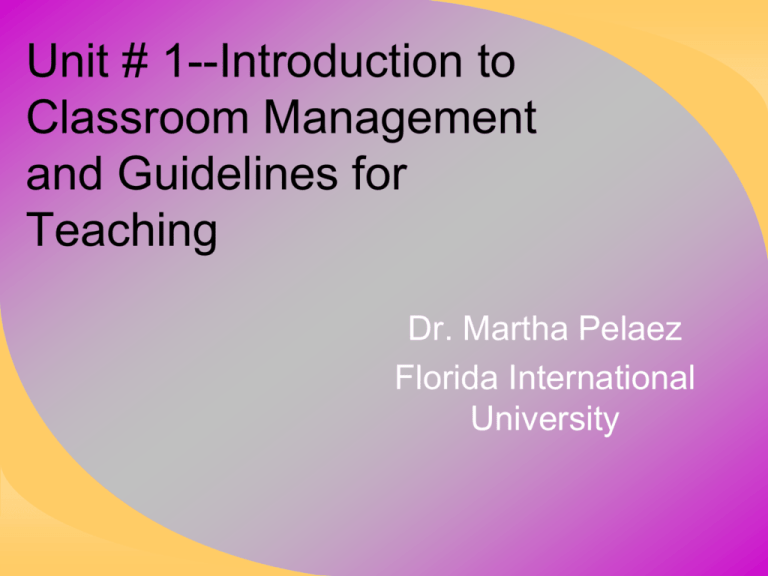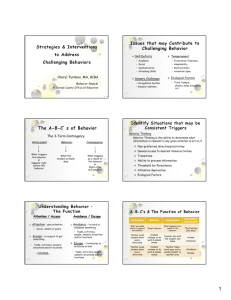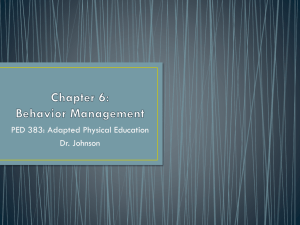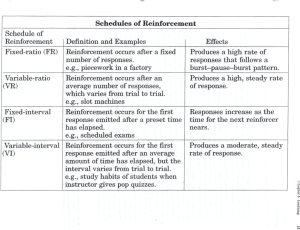1 - Florida International University
advertisement

Unit # 1--Introduction to Classroom Management and Guidelines for Teaching Dr. Martha Pelaez Florida International University Some Basic Assumptions • ALL children have a right to an effective education • Every child is a unique individual (history, temperament). • No single set of interventions or remedial procedures is effective under all conditions with all children • No matter how well designed and executed classroom intervention process may be, their effectiveness will be limited unless teachers target the function of the child’s behavior Guidelines for Teaching Guideline 1: The student is always right – That doe not mean they are always correct, but that their behavior will tell you if what you are doing is working (See law 2) Guideline 2: If you always do what you’ve always done you will always get what you have always gotten (performance predicts performance) – If what you are doing is not working try something else Guideline 3: Never let them see you sweat –“Its nothing personal, its only business” --Tony Soprano What is Behavior Management? • All action (and inaction) a teacher engages in that enhances the probability that children, individually and in groups, will develop effective skills that are productive and socially acceptable – Behavior management is a complex set of skills that must be planned, implemented, and evaluated often in an ongoing effort to provide an effective education for all students Definition of behavior management (cont.) When effectively implemented behavior management is: • comprehensive rather than piecemeal – part of the overall tactics of teaching • proactive rather than reactive – sets the occasion for student success • positive rather than negative – is designed to teach students new skills • inclusive rather than exclusive – includes ALL relevant people (students, parents, and other school personnel) Purpose of behavior management • To maintain a well run and cohesive classroom in which all students will learn • The ultimate goal of behavior management is to transfer control of teacher maintained contingencies to student self-discipline What is Teaching? According to Skinner: “We are on the verge of a new educational method a new pedagogy in which the teacher will emerge as a skilled behavioral engineer. He will be able to analyze the contingencies which will arise in his classroom and design and set up improved versions. He will know what is to be done and will have the satisfaction of knowing that he has done it.” Skinner •A teacher arranges contingencies under which a student acquires behavior which will be useful to him later on. White •Teaching is the process of building an environment so that a learner will attain preset instructional objectives. These definitions of teaching should remind teachers that: • teaching should have objectives that can be measured. • to be aware of the elements within their classrooms which might influence learning • we are responsible for arranging their classrooms so students will learn. Teaching and Learning • Six faulty notions about teaching and learning – Teachers do not need to measure student performance – Building self-esteem is an important goal – A good teacher is creative – Every child learns differently (the learning style fallacy) – Drill and practice is harmful – A good teacher is a patient teacher Faulty notions •Teachers do not need to measure student performance “The teacher who cannot or will not pinpoint and measure the relevant behaviors of the student he or she is teaching is probably not going to be very effective…Not to define precisely and to measure these behavioral excesses and deficiencies, then is a fundamental error; it is akin to the malpractice of a nurse who decides not to measure vital signs (heart rate, respiration rate, temperature, blood pressure), perhaps arguing that he or she is too busy, that subjective estimates of vital signs are quite adequate…The teaching profession is dedicated to the task of changing behavior-changing behavior demonstrably for the better. What can one say, then, of educational practice that does not include precise definition and reliable measurement of behavioral change induced by the teacher’s methodology. It is indefensible.” -James Kauffman (1997) Faulty notions • Teaching self-esteem is an important goal – Nothing succeeds like success • Self-esteem is not amenable to reliable measurement • Self-esteem is a product of an accomplishment • Self-esteem cannot be taught – In order to be creative (effectively) one must first learn how to do what has worked in the past Faulty notions • Every child learns differently – If this were true schools would be useless, there would be no way to teach except in didactic teaching (one on one) – There is no hard scientific evidence that supports the existence of different learning styles • Instead “learning styles” often become a convenient excuse for why a student did not acquire the skill that was supposed to be taught • A “learning style” is only useful to the extent that it describes the environmental conditions under which optimal learning occurs-and then only to minor degree – Although every child is a unique individual, there is a strong and continuing body of evidence that suggests that humans learn in relatively the same way. Faulty notion • Drill and practice is harmful – No one questions the coach or music teacher who has the student practice freethrows or scales – Drill and guided practice is one of the most effective methods for ensuring the student acquires the intended material Faulty notion • A good teacher is patient – Students need to learn more in less time not less in more time – The idea that a teacher must be patient translates into: • Low expectations • Fewer opportunities to respond • Low achievement – A teacher should expect her procedures to work and be stubbornly committed to the belief that her students can and will learn – Humans are not flowers who require water and sunlight in the right amounts to bloom. Teaching and Learning • Five useful assumptions about teaching – These students have the right to an effective education – Programs should be based on the individual academic needs of the student – Programs should be goal directed – Programs should be data driven – Programs should be research proven PREFERRED PRACTICES FOR EVERY STUDENT • Students want to succeed in school. – Students can succeed if they are provided effective instruction. • One of the most effective classroom behavior management systems is a well-designed academic program. – Assess the student’s repertoire to help identify and prioritize important instructional objectives – Define and task analyze the new skill to be learned – Design instructional materials and activities so the student has frequent opportunities to actively practice the skill – Provide systematic feedback (praise and error correction) – Conduct direct and frequent measurement of student performance Teacher mindsets to be motivated for success View education as a profession – Education is no better or worse than the quality of instruction provided by the teacher – Accept responsibility for learning and ask for assistance from others when it is needed Ask for the data and evaluate their believability – Demand effectiveness from your curriculum – If what you are doing is not working try something else Use differential acceptance – Witness or be the victim of acts of anger without responding similarly Focus on alterable variables – Teachers should focus effort on only those variables that make a difference in student learning and can be affected by sound teaching practice 8-13 Reinforcement • Describes the functional relationship between two environmental events – A behavior (an observable movement) – Consequence (the result of the movement • Reinforcement ALWAYS results in an increase in the likelihood of the behavior occurring again under similar circumstances Negative reinforcement (SR-) • The contingent removal of an aversive stimulus immediately following a response that increases the future rate and/or probability of that response occurring. With Negative Reinforcement • The student is "saddled" with an aversive (or threat of it). • His way out is to emit the behavior. Two Types of Negative Reinforcement • Escape • Avoidance • Two Types of Negative Reinforcement Escape terminates the existing stimulus Avoidance occurs when a response avoids (rather than terminates), a stimulus Escape Escape terminates the existing stimulus Examples: • Teacher is yelling, student follows directions to stop the yelling. • Child is hitting sibling to get her toy back, sibling returns the toy. • During math class a student is non-compliant with teacher directions and gets sent out of class. • A student hits another student who is teasing him. • A student hurries through his work making many mistakes just to get his work done Avoidance Avoidance occurs when a response avoids (rather than terminates), a stimulus • A threat exists that can be avoided if the student emits a behavior Examples • A student follows a teacher's directions to avoid having to go to the principal. • A student engages in disruptive behavior with his peers to avoid the ridicule of his classmates. • A student sits in the front of the bus to avoid being teased by his peers • A student sharpens her pencil, gets a clean piece of paper, writes, erases, then re-writes her name to avoid getting started with her work Negative Reinforcement Review 1. Negative reinforcement results in a(n) _________ in the future probability of a of a response. (increase or decrease?) • Increase 2. In negative reinforcement a(n) _______ stimulus is removed/ avoided. (aversive or pleasant) • Aversive 3. Jason, you must stay in the house and clean your room. before you can play with friends is an example of escape or avoidance • Escape ASR 4 __________ occurs when a student follows a direct so as not to be scolded by teacher (avoidance or escape) • Avoidance 5. If you are able to keep your desk neat for three days in a row you will no longer have to stay in for recess. Is this escape or avoidance? • Escape 6. True or False. Negative reinforcement has the same results as punishment • False 7. A teacher is yelling in the classroom, and the student runs away from school. Is this escape or avoidance? • Escape 8. Negative reinforcement results in an increase or decrease in the future probability of a behavior occurring • Increase Positive Reinforcement Positive reinforcement (SR+) can be defined as • when a behavior is immediately followed by the presentation of a stimulus and, as a result, occurs more often in the future. Positive reinforcer refers to • a stimulus that follows a response and increases the future likelihood of that response occurring Teaching Behaviors that indicate sensitivity to cultural and linguistic differences • Learn key words in the child’s native language • Help the student learn basic routines in class • Use visual aids when teaching Becoming a Culturally Proficient Educator • Teacher awareness and development – Cultural self-awareness is the bridge to learning about other cultures – Learn to understand differences in verbal and nonverbal communication styles – Knowledge of the different significance attached to touch, interpersonal distance, silence, dress, and gestures is important • Understanding multicultural terminology – The term “minority” represents an attempt to categorize by race, not by culture – The term culturally diverse implies no judgment of a culture’s value and does not equate cultural diversity with disability Working with Culturally and Linguistically Diverse Families • Barriers that might exist in working with families from diverse backgrounds include: – Parents may be English-language learners, less well educated, have low socioeconomic status, or be undocumented immigrants – Families may have differing views about disability, and some may hold idiosyncratic ideologies and practices about the cause and treatment of disability – The educational system may be extremely intimidating to the family • To overcome these barriers, teachers should have a general understanding of the cultural background of the student Appropriate Assessment of Culturally Diverse Students • Alternative assessment supplements the results of standardized tests • Alternative methods of assessment – – – – – Direct observations Portfolios Self-reports Inventories Interviews • Alternative assessment allows for exploration of the numerous factors and confounding variables that may be responsible for the child’s difficulties Culturally Responsive Curriculum and Instruction Questions a teacher should ask about a new culture 1.What is the group’s history? 2.What are the important cultural values? 3.Who are outstanding individuals who claim group membership? 4.What are the group’s major religions and beliefs? 5.What are the current political concerns? 6.What are the group’s political, religious, and social celebration days? 7.What are the educational implications of the answers to the preceding questions?








